| |
|
|
09.
| The Angel's Black Leg |
| |

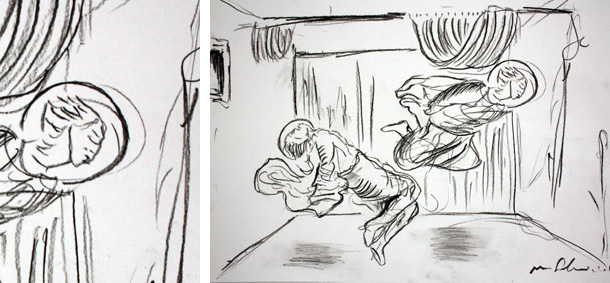
2012, serie of drawings,pencil on paper, 29,7 x 42 cm.
Exhibition view from Blinding Light, Analix Forever, 2013, Geneva.
Courtesy of the artist.
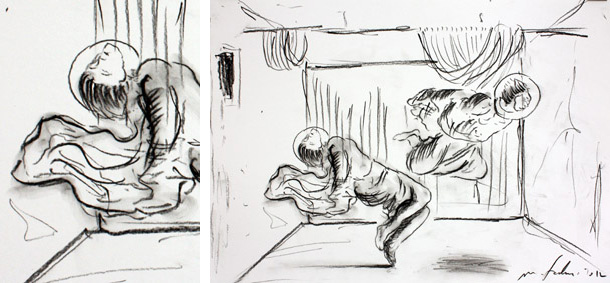
2012, serie of drawings,pencil on paper, 29,7 x 42 cm.
Exhibition view from Blinding Light, Analix Forever, 2013, Geneva.
Courtesy of the artist.
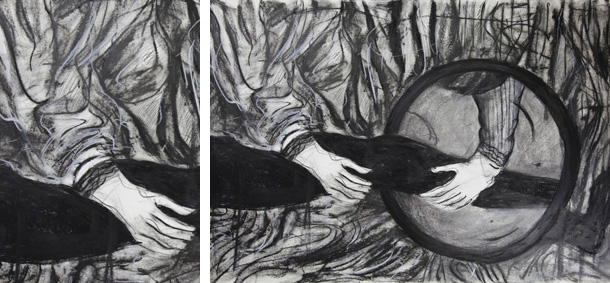
2012, serie of drawings,pencil on paper, 80 x 120 cm.
Exhibition view from Blinding Light, Analix Forever, 2013, Geneva.
Courtesy of the artist and ADN Galeria, Barcelona.
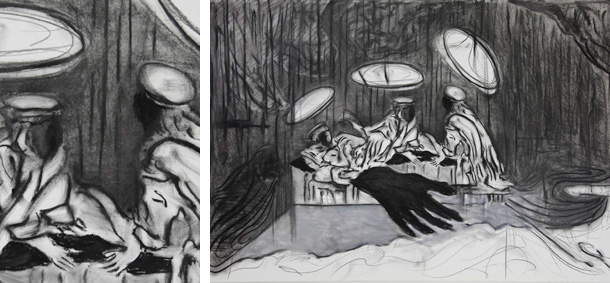
2012, serie of drawings,pencil on paper, 80 x 120 cm.
Exhibition view from Blinding Light, Analix Forever, 2013, Geneva.
Courtesy of the artist.
'' It is a striking image, unexpected and rare to this see this odd fusion of black and white, of living and dead, of the divine and of science. ''
Blaire Dessent, April 2017
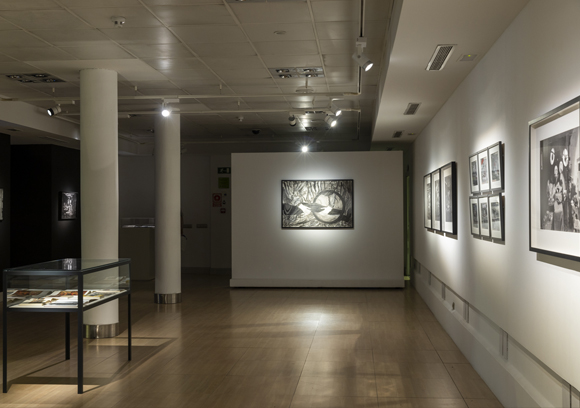
The Angel's Black Leg
Exhibition view from The Blinding Light, Casa Arabe, 2022, Madrid.
Courtesy of the artist.
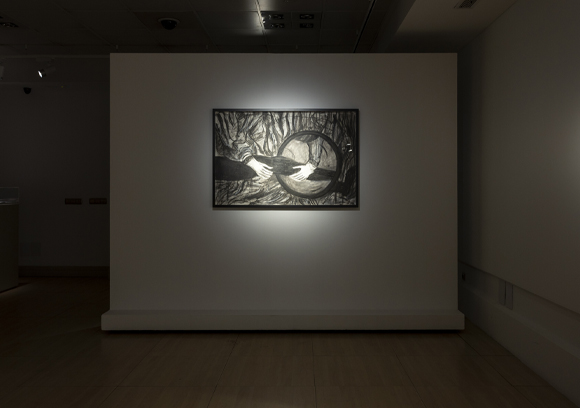
The Angel's Black Leg
Exhibition view from The Blinding Light, Casa Arabe, 2022, Madrid.
Courtesy of the artist.
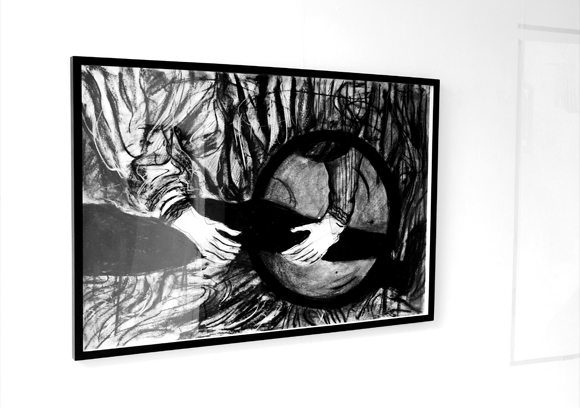
The Angel's Black Leg
Exhibition view from Blinding Light, Analix Forever, 2013, Geneva.
Courtesy of the artist.
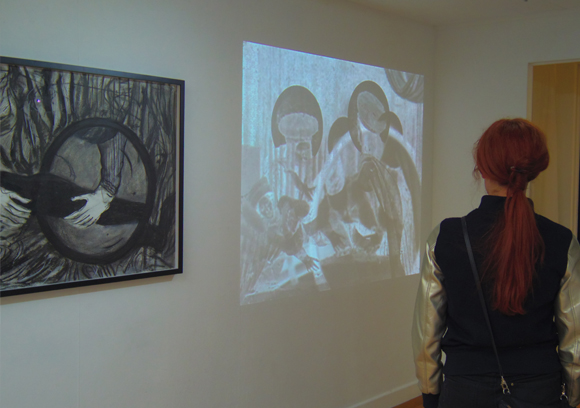
The Angel's Black Leg
Exhibition view from Blinding Light, Analix Forever, 2013, Geneva.
Courtesy of the artist.
|
|
|
|
|
|
La jambe noire de l’ange est une série de dessins au graphite en noir et blanc de 2012 qui s’inscrivent dans un projet au long cours intitulé La lumière aveuglante, inspiré par un tableau du XVe siècle, « La guérison du Diacre Justinien », par le peinte italien Fra Angelico. Le tableau montre deux saints, Côme et son frère Damien, revenus à la vie pour effectuer une opération chirurgicale, la greffe d’une jambe noire, celle d’un homme éthiopien récemment décédé, sur le diacre. C’est une image frappante, inattendue et rare de voir cette fusion étrange entre le noir et le blanc, le mort et le vivant, le divin et la science. En une seule scène, Fra Angelico remet en question les idées de race, d’hybridation et d’identité. Nés en Syrie, Côme et Damien étaient arabes de naissance et se sont convertis au christianisme lorsqu’ils ont commencé à pratiquer la médecine, une vocation qui leur valut au bout du compte le martyre et la décapitation. Ils sont considérés comme les saints patrons des médecins.
Dans cette série d’œuvres encore en cours de réalisation, plusieurs des dessins reprennent l’imagerie du tableau, mais sortie de son contexte et distordue, tandis qu’un autre dessin est une sorte de version onirique du tableau, comme si toute la scène flottait. Deux dessins sont presque identiques et se concentrent uniquement sur les deux saints, Côme et Damien, qui ont été isolés du reste du tableau et sont montrés sous une lumière différente. Avec des lignes rapides et fluides, les deux personnages flottent au-dessus du sol, l’un penché en arrière et pleinement détendu, la tête inclinée comme au repos, tandis que l’autre est plus haut, les genoux fléchis et la tête penchée en avant, comme s’il était sur le point de décoller. Les deux semblent avoir les yeux fermés, donnant l’impression qu’ils sont dans un moment de transformation qui ne dépend pas d’eux. Ils se trouvent dans une pièce qui reprend celle du tableau de Fra Angelico, et pourtant toutes les références à la chirurgie, au mobilier ou au diacre ont été retirées, pour ne laisser que les rideaux drapés et une petite fenêtre sur le côté comme uniques éléments subsistant de la scène.
Dans un autre dessin, on voit une image sombre, cadrée de près, qui montre l’une des mains du saint tenant la jambe noire. Tous les visages et le mobilier ont été retirés. La jambe est étirée et un peu ondulée, ce qui, avec les plis profonds de la toge du saint qui sont recréés à l’aide de traits superposés et répétés, crée une image donnant une impression générale de claustrophobie et sur laquelle il est difficile de concentrer son attention. Au centre du dessin, fatmi a ajouté un cercle qui soutient la jambe, un peu comme une machine à IRM ou une lampe qui éclairerait l’opération en cours. Dans le dernier dessin, on voit une interprétation du dessin de Fra Angelico dans laquelle le diacre est allongé sur le côté sur le lit et, prolongeant son bras, une grande main en forme de pince s’étend au-dessus de son chevet. La scène semble flotter soit dans les nuages soit dans une mer orageuse, leur bateau se dirigeant vers l’arrière-plan sombre. Tous ces dessins font partie du processus par lequel fatmi fait sien le tableau qui les a inspirés. Tout à la fois troublants, sereins, divins et choquants.
Blaire Dessent, Avril 2017. |
|
The Angel’s Black Leg is a series of black and white graphite on paper drawings from 2012 that are part of a larger, ongoing project titled The Blinding Light, which is inspired by a 15th century painting, The Healing of Deacon Justinian, by the Italian painter, Fra Angelico. The painting depicts two saints, Cosmas and his brother Damian, who have come back to life to perform a surgery, grafting a black leg, from an Ethiopian man recently deceased onto the deacon. It is a striking image, unexpected and rare to this see this odd fusion of black and white, of living and dead, of the divine and of science. In this one scene Fra Angelico has questioned ideas race, hybridization, and identity. Born in Syria, Cosmas and Damian were Arab by birth and later converted to Christianity when they began practicing medicine, a calling for which they were eventually martyred by decapitation. They are considered the patron saints of physicians.
In this ongoing series, several of the drawings depict imagery from the painting but out of context or distorted, while another is like a dream-like version of the painting, as if the whole scene were floating. Two drawings are nearly identical and focus only on the two saints, Cosmas and Damian who have been isolated from the painting, showing them in a different light. Using quick, flowing lines, the two figures float above the ground, one leans back in full relaxation, head titled as if in repose, while the other is higher up, knees bent and head tilting forward as if about to take off. Both seem to have their eyes closed, giving an impression that they are in a moment of transformation that is out of their control. They are in a room that references that of the Fra Angelico painting, yet all references of the surgery, furniture and deacon have been removed, leaving only the draped curtain and small window on the side as remaining pieces in the scene.
In another drawing we see a dark, closely cropped image that shows one of the saint’s hands holding the black leg. All faces and surrounding furniture has been removed. The leg is elongated and a bit wavy, which, along with the deep folds of the saint’s robe which are made with layered and repeated strokes, creates an overall image that is somewhat claustrophobic and hard to focus on. At the center of the drawing, fatmi has added a circle through which the leg is being held, a bit like an MRI machine or an overhead light that offers a clearer view of the operation at hand. In the last drawing, we see an interpretation of the Fra Angelico painting in which the deacon, lying on his side in the bed, and extending out of his arm is a large, claw-like hand that extends out and over of the bedside. The scene seems to be floating either on the clouds or a stormy sea, their boat headed into the dark background. Each of the drawings are part of fatmi’s processing the surreal painting that inspired them. Haunting, serene, divine and shocking all at once.
Blaire Dessent, April 2017. |
|
|
|